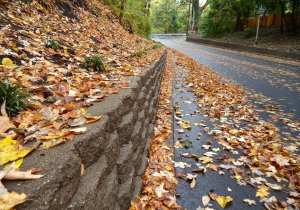 New Hope’s Department of Public Works will conduct its annual fall leaf collection program on Wednesdays starting Oct. 5 this year, and ending Nov. 30, according to a release issued late last week.
New Hope’s Department of Public Works will conduct its annual fall leaf collection program on Wednesdays starting Oct. 5 this year, and ending Nov. 30, according to a release issued late last week.
“All leaves must be placed in plastic or paper bags,” instructs the borough notice. “Bags must be tied and placed at the curb for pick up. Property owners should ensure bags are not placed in the street, and especially that they are not blocking storm water basins or drainage ways. For additional information, please contact Tom Carroll, the borough’s director of public works, at (215) 862-3031.
“Property owners should not dispose of leaf waste by raking it into the street. The borough’s street sweeper does not have the capacity to handle large volumes of leaves, and leaves blown onto the street often end up clogging the storm sewers. It is a violation of the Code of Ordinances to deposit anything such as leaves, grass clippings, dirt and debris and even snow in the winter onto the borough’s streets.
“Below are a few leaf management options, in lieu of raking and bagging leaves. Please consider employing these environmentally-friendly methods.
Let them lie
- Leaves naturally tend to collect around plants creating very useful mulch.
- Disadvantages to letting leaves lie is that they can accumulate and cause slicksidewalks when leaves get wet. Deep layers of leaves left on your grass can kill patches of grass, or can cause a snow mold to develop, requiring grass re-seeding in the spring.
- Aesthetics is another issue. Some people consider unattended leaves as untidy.
- Remember to love thy neighbor. Don’t blow your leaves into your neighbor’s yard!
Shred while mowing.
If done on a regular basis, mowing small amounts of leaves and leaving them on the lawn will not harm the grass.
Collect in bagger while mowing.
A mixture of leaves and grass makes a wonderful starter for compost or can be used as mulch.
Use as a mulch.
- Leaves used as mulch help to conserve moisture, moderate soil temperatures, reduce weeds and reduce soil erosion around plants.
- To mulch, apply several thin layers of leaves up to a depth of 3 to 4 inches or shred the leaves before application. Remember to keep the mulch six inches away from tree trunks and wait until after a hard frost before applying mulch in the fall.
Compost.
- Leaves are excellent materials for compost piles. Microbes necessary for composting are already present on leaves so you don’t need to use any commercial compost starters.
- You can use leaf compost as a substitute for peat moss when planting or add to planting areas.
- With a little basic information, leaves can be composted without being ugly, smelly, difficult or expensive!
Till into the garden.
- Before adding leaves to the garden, take time to shred them. This will make tilling easier and the leaves will decompose faster, especially leathery leaves such as oak and sycamore.
- To be on the safe side, don’t use leaves from walnut trees! They contain a chemical called juglone; this substance can retard growth of other plants.
What not to do with leaves
Do not burn.
- Contact New Hope Borough at (215) 862-3347 for Fire Code requirements pertaining to open burning. In general, the Fire Code prohibits open burning that is offensive or objectionable because of smoke or odor emissions or when atmospheric conditions or local circumstances make such fires hazardous.
- An EPA report published in November 1997 shows that a single household burn barrel may emit as much toxic chemicals as a well-controlled municipal incinerator.
Do not sweep onto the street.
- Leaves clog storm sewers creating drainage problems.
- Leaves can create fire hazards from the heat of a car’s catalytic converter.
- It is illegal to deposit raked leaves into the street.”








Leave a Comment